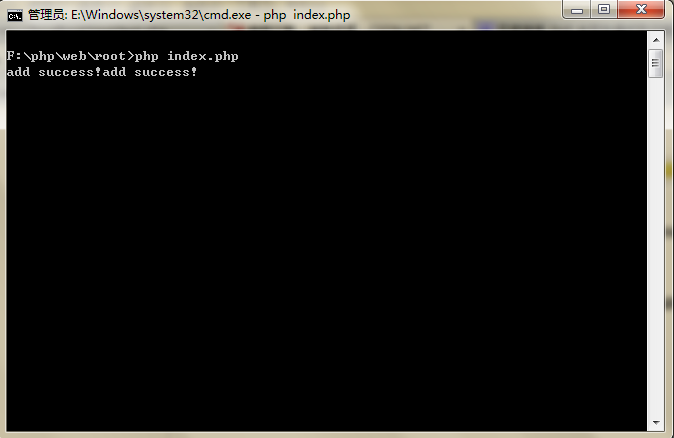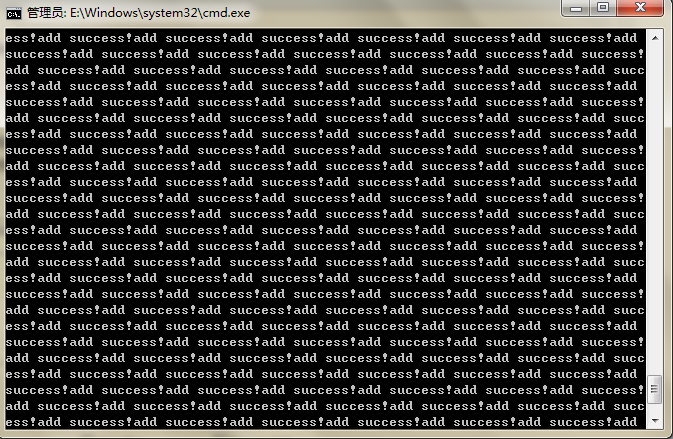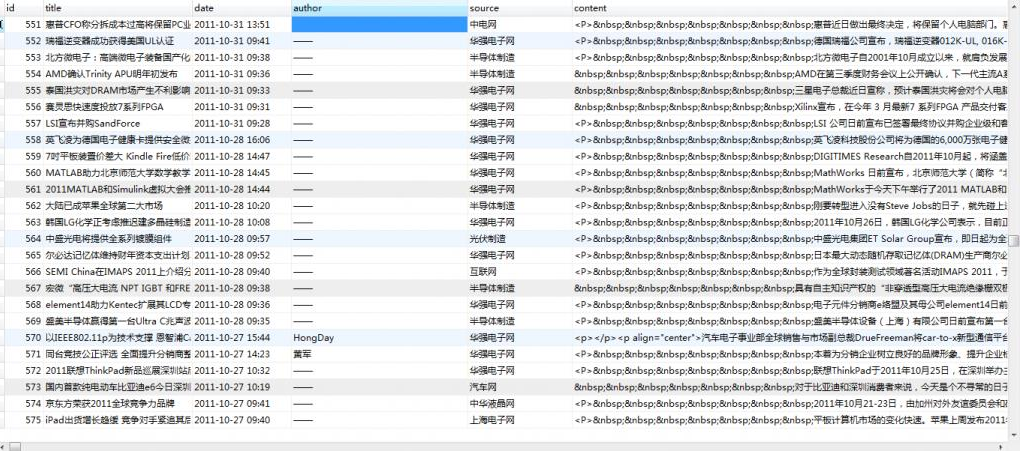為什麼使用“小偷程序”?
遠程抓取文章資訊或商品信息是很多企業要求程序員實現的功能,也就是俗說的小偷程序。其最主要的優點是:解決了公司網編繁重的工作,大大提高了效率。只需要一運行就能快速的抓取別人網站的信息。
“小偷程序”在哪裡運行?
“小偷程序” 應該在 Windows 下的 DOS或 Linux 下通過 PHP 命令運行為最佳,因為,網頁運行會超時。
比如圖(Windows 下 DOS 為例):

“小偷程序”的實現
這裡主要通過一個實例來講解,我們來抓取下“華強電子網”的資訊信息,請先看觀察這個鏈接 http://www.hqew.com/info-c10.html,當您打開這個頁面的時候發現這個頁面會發現一些現象:
1、資訊列表有 500 頁(2012-01-03);
2、每頁的 url 鏈接都有規律,比如:第1頁為http://www.hqew.com/info-c10-1.html;第2頁為http://www.hqew.com/info-c10-2.html;……第500頁為http://www.hqew.com/info-c10-500.html;
3、由第二點就可以知道,“華強電子網” 的資訊是偽靜態或者是生成的靜態頁面
其實,基本上大部分的網站都有這樣的規律,比如:中關村在線、慧聰網、新浪、淘寶……。
這樣,我們可以通過這樣的思路來實現頁面內容的抓取:
1、先獲取文章列表頁內容;
2、根據文章列表頁內容循環獲取文章的 url 地址;
3、根據文章的 url 地址獲取文章的詳細內容
這裡,我們主要抓取資訊頁裡面的:標題(title)、發布如期(date)、作者(author)、來源(source)、內容(content)
“華強電子網”資訊抓取
首先,先建數據表結構,如下所示:
CREATE TABLE `article`.`article` ( `id` MEDIUMINT( 8 ) UNSIGNED NOT NULL AUTO_INCREMENT PRIMARY KEY , `title` VARCHAR( 255 ) CHARACTER SET utf8 COLLATE utf8_general_ci NOT NULL , `date` VARCHAR( 50 ) NOT NULL , `author` VARCHAR( 100 ) CHARACTER SET utf8 COLLATE utf8_general_ci NOT NULL , `source` VARCHAR( 100 ) CHARACTER SET utf8 COLLATE utf8_general_ci NOT NULL , `content` TEXT NOT NULL ) ENGINE = MYISAM CHARACTER SET utf8 COLLATE utf8_general_ci;
抓取程序:
<?php
/**
* 抓取“華強電子網”資訊程序
* author Lee.
* Last modify $Date: 2012-1-3 15:39:35 $
*/
header('Content-Type:text/html;Charset=utf-8');
$mysqli = new mysqli('localhost', 'root', '1715544', 'article'); # 數據庫連接,請手動修改您自己的數據庫信息
$mysqli->set_charset('UTF8'); # 設置數據庫編碼
function data($url) {
global $mysqli;
$result = file_get_contents($url); # $result 獲取 url 鏈接內容(注意:這裡是文章列表鏈接)
$pattern = '/<li><span class="box_r">.+<\/span><a href="([^"]+)" title=".+" >.+<\/a><\/li>/Usi'; # 取得文章 url 的匹配正則
preg_match_all($pattern, $result, $arr); # 把文章列表 url 分配給數組$arr(二維數組)
foreach ($arr[1] as $val) {
$val = 'http://www.hqew.com' . $val; # 真實文章 url 地址
$re = file_get_contents($val); # $re 為文章 url 的內容
$pa = '/<div id="article">\s+<h1>(.+)<\/h1>\s+<p id="article\_extinfo">\s+發布:\s+(.+)\s+\|\s+作者:\s+(.+)\s+\|\s+來源:\s+(.*?)\s+<span style="display:none" >.+<div id="article_body">\s*(.+)\s+<\/div>\s+<\/div><!--article end-->/Usi'; # 取得文章內容的正則
preg_match_all($pa, $re, $array); # 把取到的內容分配到數組 $array
$content = trim($array[5][0]);
$con = array(
'title'=>mysqlString($array[1][0]),
'date'=>mysqlString($array[2][0]),
'author'=>mysqlString(stripAuthorTag($array[3][0])),
'source'=>mysqlString($array[4][0]),
'content'=>mysqlString(stripContentTag($content))
);
$sql = "INSERT INTO article(title,date,author,source,content) VALUES ('{$con['title']}','{$con['date']}','{$con['author']}','{$con['source']}','{$con['content']}')";
$row = $mysqli->query($sql); # 添加到數據庫
if ($row) {
echo 'add success!';
} else {
echo 'add failed!';
}
}
}
/**
* stripOfficeTag($v) 對文章內容進行過濾,比如:去掉文章中的鏈接,過濾掉沒用的 HTML 標簽……
* @param string $v
* @return string
*/
function stripContentTag($v){
$v = str_replace('<p> </p>', '', $v);
$v = str_replace('<p />', '', $v);
$v = preg_replace('/<a href=".+" target="\_blank"><strong>(.+)<\/strong><\/a>/Usi', '\1', $v);
$v = preg_replace('%(<span\s*[^>]*>(.*)</span>)%Usi', '\2', $v);
$v = preg_replace('%(\s+class="Mso[^"]+")%si', '', $v);
$v = preg_replace('%( style="[^"]*mso[^>]*)%si', '', $v);
$v = preg_replace('/<b><\/b>/', '', $v);
return $v;
}
/**
* stripTitleTag($title) 對文章標題進行過濾
* @param string $v
* @return string
*/
function stripAuthorTag($v) {
$v = preg_replace('/<a href=".+" target="\_blank">(.+)<\/a>/Usi', '\1', $v);
return $v;
}
/**
* mysqlString($str) 過濾數據
* @param string $str
* @return string
*/
function mysqlString($str) {
return addslashes(trim($str));
}
/**
* init($min, $max) 入口程序方法,從 $min 頁開始取,到 $max 頁結束
* @param int $min 從 1 開始
* @param int $max
* @return string 返回 URL 地址
*/
function init($min=1, $max) {
for ($i=$min; $i<=$max; $i++) {
data("http://www.hqew.com/info-c10-{$i}.html");
}
}
init(1, 500); // 程序入口,從第一頁開始抓,抓取500頁
?>
通過上面的程序,就可以實現抓取華強電子網的資訊信息。
入口方法 init($min, $max) 如果想抓取 1-500 頁面內容,那麼 init(1, 500) 即可!這樣,用不了多長時間,華強電子網的資訊就會全部抓取到數據庫裡面了。^_^
執行界面:

數據庫:
